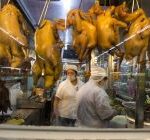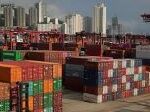I have had so much to digest for the past three days — and that’s not including the wonderful “farewell” dinner we had at a fish restaurant. That in itself was an experience. Like all of the restaurants we’ve gone to, there were no tour buses, no French fries, no gift shops. We got to this one after a long ride into the New Territories (the part of Hong Kong ceded for 99 years, whose lease expiration in 1997 triggered the return to China of all of Hong Kong — the island of HK, and Kowloon were ceded in perpetuity); parked the bus near a “wet” market, which had every fish known to me and many not known (only a mother could love a cuttlefish), and eventually wound up in the Gateway Cuisine restaurant for a real cornucopia of food. I would not have found the place, nor known what to order, but I’m glad our guide found it and ordered for us!
The trip from Guangzhou to Hong Kong was my first through the Pearl River delta area since it became the manufacturing capital of the world. The expressway is lined with factories producing almost everything available in stores in the United States and Europe, with whole cities dedicated to a single product. The region’s fortunes have gone mostly upward until the crisis hit last year, and some factories have closed, and the official word is that 6% closed. It did not look it, but the Chinese government has a major stimulus package in place to encourage less saving (about 40% versus 1% in the U.S.) and more consumption. From what we’ve seen, it’s working, at least in the short run.
It seemed fitting that one of our stops — by our request — was at a Walmart, which, were it a country, would be China’s 8th largest trading partner.  Two things struck me as different — the number of servers and the food area. Food is incredibly cultural, and it’s the one section where Walmart has had to make the greatest adjustments. There’s not just a range and variety unlike anything you’ll see at other Walmarts, but an extensive “wet” market there, too — without the flies.
Two things struck me as different — the number of servers and the food area. Food is incredibly cultural, and it’s the one section where Walmart has had to make the greatest adjustments. There’s not just a range and variety unlike anything you’ll see at other Walmarts, but an extensive “wet” market there, too — without the flies.
The other stop before the border was at a major port that is new, run by Hutchinson, a Hong Kong based company that manages ports around the world. It demonstrates, in part, the nature of the Pearl River economy, and one of the reasons for its success. The manager is a Hong Kong resident, who won my respect when he said, “First we’ll have the complimentary advertisement, then I’ll answer real questions.” Hong Kong managerial expertise and money (Hutchinson owns 65%), have helped develop China’s workforce into a major economic powerhouse.
“First we’ll have the complimentary advertisement, then I’ll answer real questions.” Hong Kong managerial expertise and money (Hutchinson owns 65%), have helped develop China’s workforce into a major economic powerhouse.
I asked him a question that seemed to take him aback — what does a port north of the border, and in China proper, do to Hong Kong. He said, after a minute, that Chinese government response to any Hutchinson’s moves was, “What will this do for the stability of Hong Kong?” As I’ve mentioned, social stability is the watchword of the regime, and the sensitivity to Hong Kong is, in my opinion, tied to the problem of Taiwan. I’ve long felt that China’s desire to “return” Taiwan to its place as a province of China tempers any moves; if China can prove it can handle two systems, the Taiwanese might more willingly be interested in one country, three systems. As I look back at my first time here, when there was genuine fear about the PRC, I can’t believe how smoothly the transition has gone. We were at UHK (the premier institution, with a lovely old colonial building as the main hall), and there was a democracy board. Among other things, a poster with Mao advertised a play directed against the proposal of the HK government to help build a fast railroad from Guangzhou to Hong Kong.
More than the Shenzhen river and two border checkpoints separate Hong Kong from mainland China, though, as I hope to explain when I continue this blog.